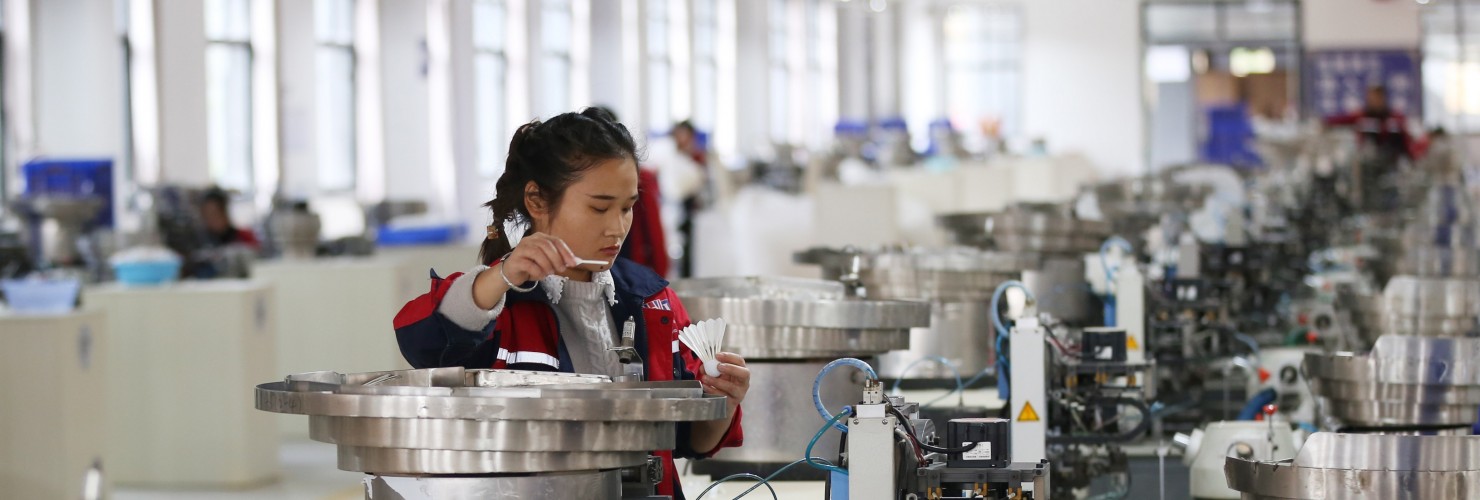

China’s economic recovery picks up pace
MERICS Economic Indicators Q3/2020
China dodged a bullet: the economic recovery picks up pace
Surging exports and imports as well as improved consumption were an attestation to the strength of China’s economy. The effective containment strategy for the virus and quickly implemented stimulus measures have been key to turning the economy around after its historic contraction in the first quarter. The CCP can now, with great confidence, start getting ready for the Party’s centennial celebrations in 2021.
The rebound gathered pace over the third quarter, expanding the economy by 4.9 percent. With GDP for the first three quarters increasing by 0.7 percent, China looks likely to be the only large economy in the world that will end the year with positive economic growth. For foreign investors China has become something of a safe haven, with investments flowing into the country.
Pictures of masses of travelers packing train stations and flocking to China’s main tourist destinations over the national day holiday in early October were clearly intended to send a strong signal: China’s economy is roaring back to life.
Compared to the fairly rapid rebound in manufacturing and investment over the first half of the year, the recovery in household consumption has lagged. A strong comeback in travel activity ought to be evidence that all is back to normal. However, the total number of trips during the “golden week” holiday was 20 percent below last year. This comes despite the holiday week being 8 days long, compared to 7 last year, due to coinciding with the mid-autumn festival.
That should be a reminder how deep the economic impact of the pandemic was on China’s economy. The recovery is still unbalanced with household consumption only slowly picking up pace. A weak labor market and low wage growth are key factors constraining households’ appetite for consumption. The stability of China’s financial system remains another vulnerability. The government’s stimulus was successful in shoring up GDP growth, but has also resulted in accelerating credit growth.
Stimulus measures are likely to stay in place until household consumption and the labor market are on a more solid footing. But bar a second Covid-19 outbreak, China’s economic recovery is well on track.
Macroeconomics: Stronger consumption boosts GDP growth towards pre-pandemic levels
- The end of lockdowns and an influx of state support have successfully engineered an ongoing rebound in China. In fact, China is now the world’s only major economy to not be in recession. In Q3 real GDP expanded by 4.9 percent, up from 3.2 percent in Q2. Year to date, the Chinese economy is 0.7 percent larger than the same time last year.
- Compared to the previous quarter, the economic recovery is on a more stable footing as consumption has now come back to life. In contrast to the previous two quarters, where consumption was a drag on GDP growth, in the third quarter it accounted for 34.9 percent.
- But investment activity continues to be the main driver of the economic recovery. Gross capital formation is the single largest contributor, accounting for 2.6 percentage points (52 percent) of GDP growth in Q3.
- This is reflected in the strong growth in construction activity connected with the government’s stimulus measures. Construction expanded by 8.1 percent in the third quarter, up from 7.8 percent in the previous quarter.
- Stronger domestic demand and largely unaffected foreign demand helped the manufacturing sector pull ahead. Growth accelerated to 6.1 percent, recovering the losses over the first quarter. For the year, growth reached 0.5 percent.
- The services sector grew at 4.1 percent year to date in spite of being pulled down by the hard-hit travel related services. For example, accommodation and catering contracted by 5.1 percent. Meanwhile, stronger demand for IT services resulted in 18.8 percent growth in that sector.
What to watch for: As consumption improves, stimulus driven investment should fall.
Business: As demand picks up steam, manufacturing recovery accelerates
- Manufacturing remained a bright spot in China’s economic recovery. Growth steadily picked up, expanding by 6.9 percent in September. Growing by 1.2 percent in the first nine months, the improvement was strong enough to recover the losses caused by the shutdown earlier in the year.
- Output for construction related products has mainly recovered amid stronger demand. Production benefited from resilient real estate investment and government stimulus efforts. Steel output increased by 12.3 percent in September, while cement production expanded 6.4 percent.
- Improving domestic and external demand helped lift private sector production. Private companies’ value-added production accelerated to 8.9 percent in the third quarter, well above 7.7 percent growth in 2019. Year to date growth recovered to 2.1 percent, outpacing both SOEs (0.9 percent) and foreign owned companies (0.3 percent).
- Automobile production stepped up again in September following a slight growth slowdown earlier in the quarter. Overall growth remains strong: production increased by 16.6 percent in the quarter. The recovery comes amid soaring growth in output of new energy vehicles (up 51.1 percent in September). However, new energy vehicles only accounted for 5.5 percent of production capacity. The improvement in September was largely due to stronger growth in the production of combustion engine vehicles.
- Business expectations have regained optimism. The Purchasing Managers’ Index for both manufacturing and services have returned above 50, indicating an improved business outlook. A positive outlook for new orders gives reason to believe that the recovery is on a solid footing.
What to watch: Exports may sour over the fourth quarter if major markets in EU and US suffer, impacting production at private companies.
International trade and investment: Exports growth helps lift economic recovery
- China’s exports have remained dynamic, expanding 9 percent year-on-year over Q3 in USD terms. Robust foreign demand over the course of the pandemic has meant that exports have nearly recovered from the lockdown in China earlier this year: year-to-date exports contracted by 0.8 percent.
- Exports benefited from an uptick in foreign demand for consumer goods after easing of restrictions. Shipments of electronics expanded by 17 percent, following a 5 percent drop in the first six months. Meanwhile foreign demand for health care products has slowly receded in Q3 following a surge at the onset of the pandemic. Demand for medical material and pharmaceuticals expanded by 24 percent, compared to 45 percent in the previous quarter.
- Import growth accelerated over the quarter reaching 13.8 percent in September, outpacing export growth. The rebound coincides with a more broad-based recovery in the Chinese economy. For the first nine months imports contracted by 3.1 percent.
- China’s trade surplus with the US eased slightly in September, reaching 30.8 billion USD driven by demand for agriculture products and high-tech (especially semiconductors). Despite the improvement, China is still a long way off from the Phase 1 purchase commitments made in December last year.
- Growth of utilized foreign direct investment sustained its momentum over the summer following a catch-up rebound at the onset of the pandemic. Foreign companies remain keen on further investing in the Chinese market. Inflows in the first three quarters have already surpassed 2019 levels over the same time period.
What to watch: As Europe and the US struggle to contain the pandemic, Chinese exports of consumer goods might be impacted.
Financial markets: Economic rebound carried by leverage
- Monetary policy remains active in supporting the economy and asset prices, and in ensuring sufficient liquidity to avoid distress. The PBOC left reserve requirements and interest rates unchanged in Q3 and was, instead, very active with injections. Since June, the PBOC has lent a total of 5.2 trillion CNY through its medium-term lending facility.
- As a result, leverage has increased. By the end of Q3 aggregate outstanding credit had grown by 13.5 percent compared to 12.75 percent at the end of Q2. Credit growth has accelerated significantly during the past three quarters, but nominal GDP, which captures the ability to service that debt, has not grown at anything like the same pace.
- The Chinese government has been keen to build the domestic bond market. But it looks like the bond market’s growth has peaked for the moment: outstanding corporate bond financing, which had accelerated throughout the year, slowed somewhat in Q3, growing at 20.6 compared to 21.4 percent in Q2.
- Shadow banking aggregates are recovering, likely driven by the needs of the underfinanced private sector. Total credit outstanding in shadow banking aggregates is now 3 percent lower than last year, compared to 5 percent in Q2.
- China’s stock market is performing well in comparison to global indices. After taking a beating in the first part of the year, equities are now up 7 percent ytd. The Chinese stock market has benefitted from foreign capital inflow, a recovering economy, loose monetary policy and several large IPOs.
- The quality of credits in the financial system, particularly those tied to property markets, remains highly questionable. Evergrande, China’s largest property developer, has been struggling with enormous debts at high interest rates.
What to watch: The US may introduce financial sanctions on China.
Investment: Strong growth of investment in digital infrastructure and real estate
- Government intervention and loose credit conditions have enabled fixed asset investment to recover in Q3, expanding 0.8 percent for the year. The rebound was driven by stronger investments by state owned entities (SOEs) which benefit from the stimulus and loose credit conditions. While investments by SOEs increased by 4 percent in the first nine months of the year, private companies´ investment contracted by 1.5 percent.
- Investment from mainland Chinese enterprises lagged behind, expanding only 0.7 percent. Meanwhile investment of foreign funded companies and those from Hong Kong, Macau, and Taiwan grew at 5.3 and 4.9 percent, respectively.
- Despite the latest economic improvement, manufacturing companies are putting off expanding capacity. Investment is only gradually improving and continues to contract, with year to date investments down 6.5 percent.
- As part of the stimulus, investments in transportation infrastructure are helping to buoy up overall investment levels carry investment. But they are not the main drivers. Overall infrastructure investment grew only 0.2 percent, compared to -2.7 at the end of Q2. By contrast, investment in IT grew by 33.4 percent as China’s government doubled down on improving its digital infrastructure.
- Real estate, which contains a very large share of total investment, is another big driver. It expanded from 1.9 in the second quarter to 5.6 percent by the end Q3. Most of this was in residential buildings, which grew 6.1 percent, compared to investment in office buildings, which grew only 0.5 percent. Land transactions grew by 13.8 percent suggesting even more property will be constructed in Q3.
What to watch: Private investment will need to increase as the economy picks up steam.
Prices: Sluggish demand fails to lift prices
- Despite the improvement in the economy over the third quarter, the latest inflation data indicates that both industrial and consumer demand continued to be weak. With deflationary risk on the rise, the government will be inclined to continue with its expansive fiscal and monetary policy until demand picks up.
- The effects of the African swine flu on pork prices became more moderate over the quarter. Price increases eased from 85.7 percent in July to 25.5 percent in September as supply recovered. This has been a major reason why inflation has eased. The CPI increased by 1.7 percent, the slowest in 19 months.
- Producer prices trended upward over much of the third quarter following a low point in May, when prices contracted by 3.7 percent. However, the trend lost steam in September with prices falling by 2.1 percent. This may hint at more persistent weakness in industrial demand.
- An exception has been the rising price for ferrous and for non-ferrous products due to higher demand for steel and aluminum. Prices for non-ferrous metals increased 2.3 percent in the third quarter, after contracting 4.2 percent in the previous quarter. Meanwhile prices for ferrous metals stopped contracting in September. The rapid increase in prices is a result of strong construction activity underpinned by the government stimulus measures.
- For China’s real estate market, the pandemic was largely a non-event. Sales remained robust throughout the year, sparing the government form any major intervention. Price growth in 70 cities continued to ease down steadily to lower levels of growth over the past 16 months, expanding by 4.7 percent in August.
What to watch for: PPI may continue to fall if demand does not pick up considerably in the fourth quarter.
Labor market: Under pressure: stabilizing employment still a challenge
- As the economy gains momentum, the labor market is only gradually improving. Surveyed unemployment fell to 5.4 percent in September following a spike to 6.2 percent during the height of the pandemic in February. The slow recovery in private consumption remains a major restraint on new hiring.
- New urban jobs totaled 8.98 million in the first eight months. This is far below the 2019 figures of well above 10 million during the same time period. The government will easily surpass its target of 9 million after revising it downward from 11 million.
- But stabilizing employment remains a key priority. Underscoring the urgency, Premier Li Keqiang announced further measures in a State Council executive meeting on October 9. Support policies are focused on preventing layoffs, upgrading skills, reducing tax, and providing one-off payments for income loss.
- The government is particularly concerned over the bleak outlook of the 8.74 million university graduates expected this year. Small and medium sized private companies continue to hold back on hiring. In response, government departments and state-owned enterprises have created 2.8 million jobs for graduates, up by 700,000 compared to the same period in 2019.
- Growth of nominal disposable income rebounded to 3.9 percent from 2.4 percent for the first half of the year. Adjusted for price effects, the increase was 0.6 percent. Wage growth will likely remain weak in 2021, with unskilled workers most affected. By the end of the third quarter, only Fujian, Qinghai, and Guangxi increased minimum wages, the latter being the only province with a post-pandemic increase.
What to watch: Stronger private sector employment will indicate whether the economic rebound is on a more stable footing.
Retail: Consumer spending is slowly bouncing back
- Recent reports published in Chinese and international media highlighting flourishing travel activity over the National Day Holiday were intended by the government to draw attention to China’s economic recovery. However, the picture was not quite as rosy as presented. Compared to 2019 travel figures in fact contracted by 21 percent while tourism spending was down 30 percent over the eight-day holiday. Given the circumstances this is good, but it also shows how far China’s economy is from full normalization.
- Retail growth picked up steam over the third quarter, returning to growth for the first time since the lockdown in the first quarter. In September, retail spending improved considerably, expanding by 3.3 percent. However, consumption behavior is still far from reaching post-pandemic growth.
- Consumption for the first nine months was down by 8.6 percent. Despite improvements in the Chinese economy, households are still dealing with a higher degree of uncertainty around the labor market and their income. This has slowed the demand for non-essential goods including furniture (-0.6 percent), household appliances (-0.5 percent) and electronics (-4.6 percent).
- An exception was automobiles, where sales were strong with quarterly growth at 11.8 percent – the highest since 2016. Sales were lifted by incentives and stimulus measures, including increased demand for commercial vehicles as part of higher infrastructure spending.
- The hard-hit restaurant business continued its slow recovery over the third quarter. In September growth was down 2.9 percent – a major improvement compared to the end of the second quarter when the sector contracted by 15.2 percent. Full recovery is, however, still far off. Year-to-date restaurant spending is down 20.8 percent.
What to watch: Restaurant and travel figures will provide a good indicator of how far household spending is normalizing.

